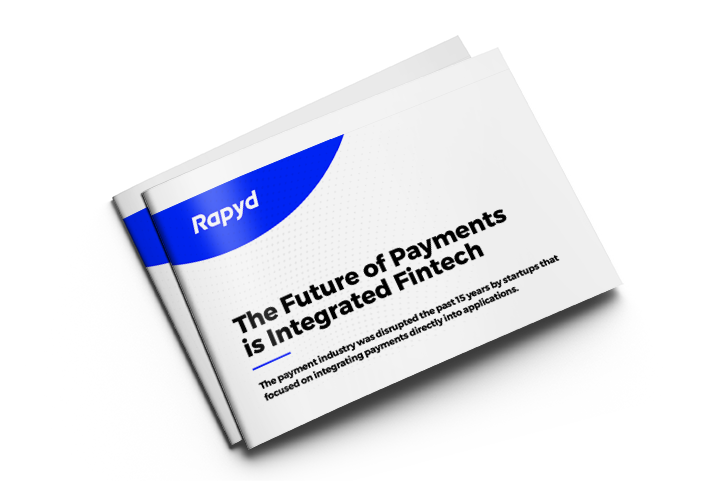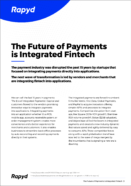Here’s how open banking in fintech is reshaping the global financial sector.
Table of Contents
- Here’s how open banking in fintech is reshaping the global financial sector.
- How Companies Can Leverage Open Banking
- How Do APIs Work in Open Banking?
- Learn how Rapyd’s Fintech as a Service Powers Open Banking
- The Future of Payments is Integrated Fintech
- Open Banking Examples and Use Cases
- How Open Banking Works Around the World
- Explore Open Banking with Rapyd APIs for Global Financial Services
- Leverage the Power of Open Banking
For years, merchants and individuals dealt with the complexities of legacy banking operations. Lack of transparency, accessibility and lengthy bank processes pose numerous challenges. Each financial product and service was siloed, leaving businesses without a clear picture of their operations, unable to share information with other parties, and forcing customers to complete countless documents and verification processes for the most basic financial tasks. Tasks as basic as loan and credit card approvals could take months. Open banking promises to make everyday financial activities faster and easier for consumers and fintech innovators.
How Companies Can Leverage Open Banking
Open banking eliminates these bottlenecks. It enables the sharing of customer data from banking and non-banking institutions to third-party service providers. This can radically streamline operations and improve the customer experience.
Open banking also gives product managers and developers much greater flexibility in localizing user experiences and minimizes the need to invest resources in backend infrastructure.
Companies can leverage open banking to create all kinds of financial products and innovations, like apps that help with personal budgeting, investments, or those providing customers with instant credit scores.
The simplified financial experiences of open banking are also encouraging new customers to participate in financial markets. Juniper Research predicts that the open banking user base will grow at an annual rate of 50% between 2020 and 2024.
Open Banking Allows Companies To:
- Be more customer-centric: Deliver data-centric customized products and services to customers.
- Start new revenue streams: Customers need innovative products to manage their finances. You can build such products based on the data trends you witness and create a new revenue stream.
- Gain a competitive edge: Acquire and retain more customers with customer-centric and innovative products and stay ahead of the competition.
- Create greater operational efficiencies: Gain a comprehensive understanding of your operations and financial flows.
How Do APIs Work in Open Banking?
An Application Programming Interface (API) is a software interface that lets information be exchanged between two different applications. APIs provide a standard and safe way for applications to work together and share requested information and functionality – without the need for user intervention.
Open banking is also called API banking because it uses fintech APIs to connect banks, fintech, and third-party service providers to give them far richer data and greater functionality.
APIs can connect data from banks and non-banking institutions, process it, and send it to third-party applications. The customers can access these applications to view and manage their financial details in a single interface. Integrating financial data with APIs also gives businesses a clearer picture of their customer’s financial situation and risk profile, which helps them offer more personalized products and services.
There are concerns about data security and privacy when using APIs for open banking. From third-party apps that misuse customer account information to data breaches to hacking and fraud, businesses must use best security practices to ensure secure online payment processing to significantly reduce risk. This then opens the door to using open banking for more personalized and valuable customer relationships.
Learn how Rapyd’s Fintech as a Service Powers Open Banking

Open Banking Examples and Use Cases
Here are a few use cases and examples of fintech applications enabled by open banking:
- Personal Financial Management (PFM): You can recommend PFM products to help customers manage their finances efficiently. You can extract their data from various sources and consolidate them in a single platform to give them an overview of their finances. Mint and Wealthfront offer similar services.
- Financial Product Aggregator: You can provide your customers details of the various financial products such as loans, credit cards that they hold in one interface. Plaid, Tink, and Nordic API Gateway offer such services.
- Recurring Payments: We live in a subscription economy. Customers who have signed up for many subscriptions need a service to track and manage them. You can provide a recurring payment service to customers. Check out how Subaio and Aptap offer these services to customers.
- Checking Credit Risk: You can leverage open banking to help lenders and underwriters instantly access the applicant’s credit history and make faster credit risk decisions. Klarna, Afterpay, and ZipPay are a few examples in this space.
Learn why the next wave of fintech transformation is led by vendors and merchants that are integrating fintech into applications.
How Open Banking Works Around the World
Open banking has simplified global transactions. But there are noticeable differences in interpretation and adoption globally. Here’s a snapshot of the market readiness and regulatory policies in different countries.
Open Banking in the European Union
In the EU, open banking is regulator-driven. They implemented the Payment Services Directive 2 (PSD 2) to integrate the EU’s payment market, provide open access to data, and protect customers. The European Banking Authority (EBA) drafts the guidelines and the Network and Information Systems Directive oversees cybersecurity implementation. The fintech space is still evolving. New players are entering the space with innovative business models. Several banks have laid down the minimum regulatory requirements measures, and some have yet to realize the full potential of open banking.
Open Banking in the UK
The PSD2 regulation is responsible for the UK’s well-established open banking framework. The Competition and Markets Authority (CMA), Financial Conduct Authority (FCA), and HM Treasury (HMT) oversee it, while the GDPR governs the data privacy laws.
The fintech sector is experimenting with innovative business models. Account aggregation is their main use case. In January 2020, the CMA recognized the nine largest banks as compliant. They also acknowledged 204 accredited third parties as open banking service providers.
Open Banking in the US
In 2018, the US formed a non-profit consortium called Financial Data Exchange (FDX) with fintechs and banks. The aim was to standardize customer-consented data-sharing. The Dodd-Frank Act gives customers the right over their financial data. US customers are credit card-focused. But they are warming up to alternate and faster payment modes, which has given rise to new business models.
Open Banking in Singapore
The Monetary Authority of Singapore (MAS) and Association of Banks in Singapore (ABS) have created a Finance as a Service API playbook that enlists a choice of 400+ banks. Singapore has a Personal Data Protection Act that applies to all private sector organizations. The Cybersecurity Act, 2018 monitors, and reports cybersecurity threats.
Singapore has high-level guidelines for open banking in fintech. However, no detailed framework or operational requirements are available. Singapore also has a mature Fintech sector. But, the country is witnessing low utilization due to a lack of standardized API, common infrastructure, and processes.
Open Banking in India
India follows the Personal Data Protection Bill, 2019, to protect personal data. The Reserve Bank of India (RBI) governs the regulations. It has prescribed Account Aggregator (AA) guidelines for permissible activities and API specifications. The National Payments Council of India (NPCI) launched Unified Payments for payment Initiation better known as UPI. India is witnessing a surge in the fintech space due to digital adoption. Financial institutions are also taking initiatives to spread awareness and financial inclusion. Account aggregation use cases are popular in India.
Explore Open Banking with Rapyd APIs for Global Financial Services
Open banking in fintech is more agile, customer-friendly, and inclusive than legacy banks. Customers can do business globally without worrying about lengthy verification processes and can instantly and securely share their financial information. It has also empowered customers to have more control over their financial decisions by being able to share their information with trusted apps for more tailored experiences.
Leverage the Power of Open Banking
Rapyd allows fintechs to fully leverage the potential of Open Banking by offering REST APIs so you can easily incorporate payments, payouts, ewallet and issuing functionality into any website or application.
By integrating Rapyd APIs in your platform or service, your organization can accept payments and disburse funds using the local payment methods your global partners and customers prefer, often with significantly lower FX and transaction fees.
Plus, our APIs are designed to protect transactions with AI-powered fraud monitoring and manage compliance wherever you do business. There’s no better time than now to build an agile and future-ready financial business.
Sources Cited
Juniper Research. Open banking users worldwide by region 2020 | Statista. 19 Oct. 2021, https://www.statista.com/statistics/1228771/open-banking-users-worldwide/.
Accenture. HOW BANKS CAN THRIVE IN AN API ECONOMY. https://www.accenture.com/_acnmedia/pdf-100/accenture-how-banks-can-thrive-api-economy.pdf.
API Open Banking – NuWireInvestor. 15 Oct. 2021, https://www.nuwireinvestor.com/api-open-banking/.
Subaio. 5 Examples of the Best Open Banking Use Cases. 15 Jan. 2021, https://subaio.com/the-5-best-use-cases-of-open-banking/
Deloitte. Open Banking Report. https://www2.deloitte.com/content/dam/Deloitte/in/Documents/financial-services/in-fs-open-banking-report-noexp.pdf.
Virtusa. Why Open Banking is Key to Increasing Financial Inclusion. 3 May. 2019, https://www.virtusa.com/perspectives/article/why-open-banking-is-key-to-increasing-financial-inclusion.
Photo by Kindel Media for Pexels
Subscribe Via Email
Thank You!
You’ve Been Subscribed.




